Photo by Jo Leonhardt on Unsplash
… And why are winemakers (and wine nerds!) so in love with it? In short, it tells the story of the grape and what the wine might show you. Who doesn’t love a good story?
It’s a Romantic Notion
When you hear the word “terroir,” a typical image might come to mind: a fancy-looking wine professional (“Sommelier,” as some are called) swirling a glass of ruby colored wine while describing it as being from a “good year.”

The story goes something like this. The sun was hot that year, and the rain was minimal. The vineyard owner and their dog regularly walk the rows of grape vines situated on a hillside overlooking a river. And when harvest is near, they check daily – their hands dirty with soil, stained from the fruit, waiting for just the right moment to pick. “This wine being served,” the Somm goes on to say, “was born of sweat, tears, and passion for producing the best fruit that becomes the absolute best wine possible.”
Photo by Andrea Cairone on Unsplash
How romantic does this story sound? Pretty romantic, if you ask wine nerds!
But It’s Not Just Romantic, It’s Also Scientific!
While the story paints a beautiful picture of the place and face behind the bottle, it also provides some hints about what to expect with how the wine tastes and smells (wine nerd code!). Let’s decode the story, shall we?
First, we should know what makes a “good year” for wine grapes. Many red wine grapes, particularly those with thicker skins (such as Merlot, Cabernet Franc, and Syrah) need a lot of sunshine and warmth to fully ripen, and not too much water to swell and dilute the fruit. So, for these varietals, “a good year” is a warm, drought year. These years produce riper, sweeter, more concentrated tasting and smelling wine.
Other varietals (particularly whites) need cooler conditions and a bit more rain, so the fruit doesn’t ripen too quickly and lose its freshness and acidity.

Photo by Ales Maze on Unsplash
A “good year” for a wine means the weather conditions were ideal for the grapes in the vineyard where they were grown.
That explains the first part of the story, but what about the vineyard situated on the hillside overlooking a river? Yes, there’s a scientific explanation for that, too! So… What does water do? It reflects sunlight (what grapes need to ripen, remember?). And… What does the hillside do? The slope directs water down the hill and away from the vines. Also, the elevation might create a cooling effect in the evening, slowing down the ripening process.
So, you see, the vines were planted in this particular place to make the best use of the surrounding natural elements and mitigate or make up for what can’t be controlled (the weather) – all with the goal of managing ripening and reducing fruit swell. Makes sense, right?
It’s All About the Growing Environment
So, have you figured out what “terroir” is? That’s right! It’s the land and environmental factors that contribute to how wine tastes and smells. While there is much that can be controlled in the winemaking process after the fruit is harvested, there is only some control in the environment that grows the fruit.

Terroir: The place chosen to grow the wine grapes, based on the region’s climate and natural elements that contribute to growing conditions.
This is what makes terroir so special. It is the place that was especially chosen to grow the fruit, providing the very best possible growing conditions.
Photo by Karsten Würth on Unsplash
Now you can see why winemakers and wine nerds are so enamored with the concept. In short, terroir is the foundation for what makes a truly great wine!
Published June 1, 2022
What do you know about “terroir”? Share in the comments below!


